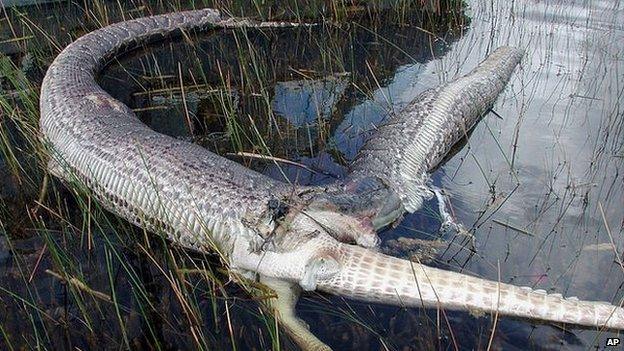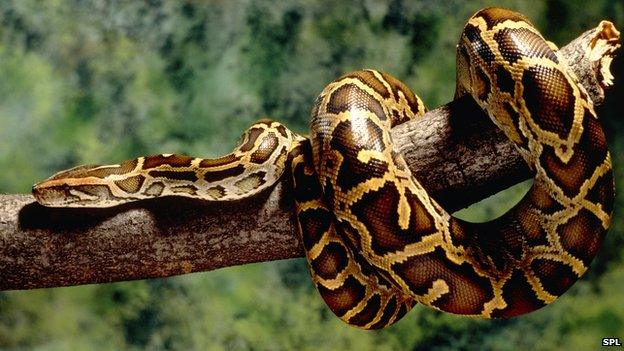Giant pythons have 'homing instinct'
- Published

This enormous Burmese python burst trying to swallow an alligator in Florida in 2005
Giant Burmese pythons have map and compass senses which help them travel "home" over vast distances, scientists have been surprised to discover.
Pythons captured and relocated in Florida's Everglades - where they are an invasive species - returned 23 miles (36km) to their original start point.
It is the first evidence that snakes may share a similar magnetic compass to other reptiles, such as sea turtles.
The findings are published in the Royal Society journal Biology Letters, external.
The Burmese python (Python bivittatus) is one of the largest snakes in the world. The biggest specimen ever caught measured more than 17ft (5m) and weighed 164lb (74kg).
The snakes coil around their prey and suffocate it - and have been known to swallow animals as large as alligators, external.
Although native to South East Asia, they have become established in Florida's Everglades National Park - where they have been blamed for a staggering decline of mammals.
To study how these invasive predators migrate and spread, researchers captured 12 snakes and fitted them with GPS radiotransmitters.
Half were released where they were captured, but the other six were transported to other suitable habitats in the Everglades 13-23 miles (21-36 km) away.
Using aircraft to track their movements, the researchers were stunned by how quickly the snakes travelled homeward.

The pythons could navigate by the Sun, the stars, or by a magnetic compass
Five of the six returned within 5km of their original capture location - and their movement was faster than the control snakes.
"We were very surprised," said lead author Shannon Pittman, of Davidson College, North Carolina.
"We anticipated the pythons would develop new home ranges where they were released. We didn't expect them to orient back to their capture locations.
"This is evidence that Burmese pythons are capable of homing on a scale previously undocumented in any snake species."
The experiment suggests the snakes have both a map sense (to determine their position in relation to home) and a compass sense (to guide their movement home).
Researchers say the map could be magnetic, like sea turtles, while the compass could be guided by the stars, olfactory (smell) cues, or by polarised sunlight - all of which have been shown to be used by reptiles.
The Burmese python was found in a Florida shed, as Claudia Redmond reports
"Other snakes likely do share this ability with pythons. But our understanding is limited by a dearth of research on the subject," Ms Pittman told BBC News.
Some previous studies found that smaller snakes - sea kraits and garter snakes - can home over short distances, but not large constrictors.
"I'm impressed, but I'm not surprised - this verifies what many of us in the field have been seeing for years," said Dr Stephen Secor of the University of Alabama, who researches Burmese python physiology, external.
"Reptiles know where they're going - it's not just random. They're familiar with their home range.
"And I suspect that, if pythons can do this, all snakes can do it - rattlesnakes, vipers, the lot."

Dr Stephen Secor says the pythons are actually gentle, docile creatures
Keeping in familiar territory may help snakes to find prey and mates, and the homing sense may allow them to return to their territory after exploratory forays, Ms Pittman said.
"We know that snakes tend to come back to some of the same sites throughout their lives - such as overwintering locations or refuges," she told BBC News.
Understanding how invasive pythons migrate could help control their spread in Florida, she suggested.
But Dr Secor said the threat to the Everglades had been overstated: "Some people want to sell it as an ecological disaster. It's really not.
"Burmese pythons can't ever move beyond the Everglades. It's too cold. The minute it freezes, it kills them," he told BBC News.
"They're actually very docile, gentle snakes. People who don't like them don't know a lot about them. They're pretty amazing animals and we can learn a lot from them."
And the first lesson we can learn from their homing ability, said Dr Secor, is "don't pick reptiles up".
"People see turtles crossing the road and try to move them to safety. But if you take them away, they're just going to try and come back. You are doing more harm than good.
"Likewise with snakes - people find them in their yard, drive them off and dump them a mile down road. Then, three days later, the snake comes back.
"I hear these stories frequently: 'It came back! The same snake!' And I'm always kind of sceptical. Is it really the same snake? Or just another one that looks similar?
"But maybe these people were right all along. The snake really did come back."
- Published5 August 2013
- Published3 March 2014
- Published11 January 2013